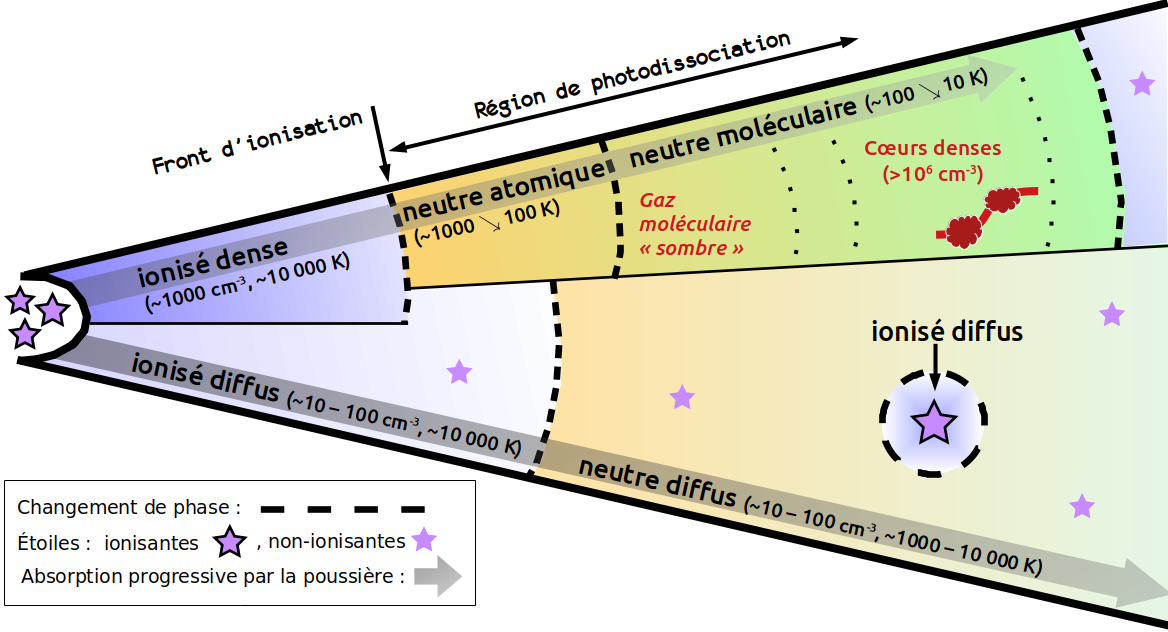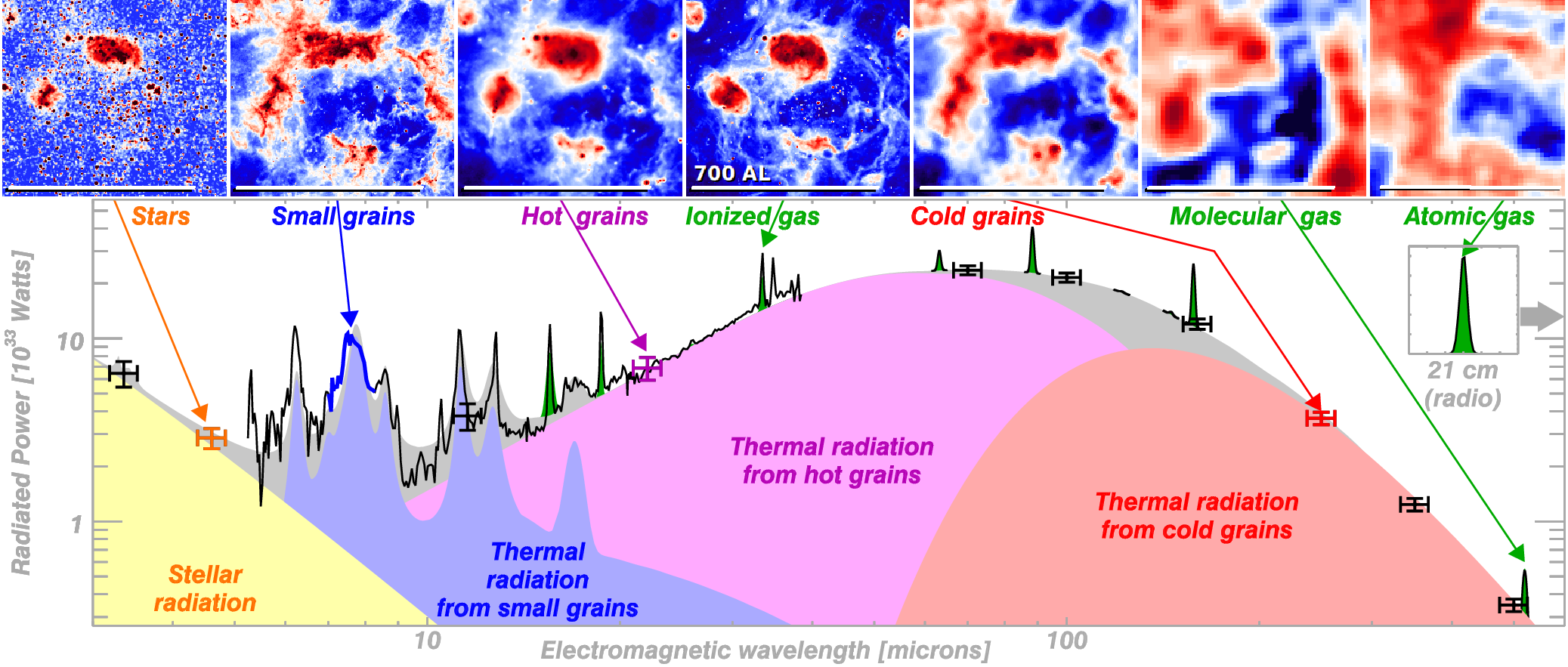The interstellar ecosystem
Table of Contents
As its name implies, the interstellar medium (ISM) fills the space between the stars within a galaxy and is far from empty: it represents about 20% of the mass of visible matter in the Milky Way. In general, the ISM is very sparse, with an average of one particle per cm3 (10 billion billion times less dense than Earth’s atmosphere). This medium is part of an ecosystem within which the stars – formed by gravitational collapse of molecular clouds – act in return via their radiation and their violent ejection of matter. Our understanding of the ISM has been considerably improved in recent years, notably through the observation of nearby galaxies.
1 A multi-phase medium…
The ISM consists of gas (atoms and molecules) and dust grains. The gas comprises about 73% hydrogen and 25% helium; the remaining 2% are the so-called “heavy” elements (O, C, N, Fe, etc.) which are produced during the stellar evolution . The grains are solid particles smaller than one micron (smaller than bacteria).
The effect of stellar radiation is to dissociate the molecules and ionise the atoms, thus producing different “phases” (Fig. 1). On the surface of molecular clouds, where hydrogen takes the form of H2, the carbon monoxide molecule CO is dissociated. For convenience, though, it is often by observing CO that we measure the mass of moleculargas. There is thus a molecular region which can easily elude the observations: this is the “dark” gas.
Stellar radiation also has the effect of heating up the ISM through energy transfer via ionisation or the photoelectric effect on grains in the atomic regions. The gas thus heated then cools down while emitting discrete (spectral lines) or continuous radiation. The cooling of the gas and the shielding of the ionising radiation create conditions favourable to the formation of future stars. Taking it to the extreme, elliptical galaxies, in which there is almost no ISM, have pretty much ceased to form any stars.

Figure 1: Schematic view of the stratification of ISM phases. Clusters of young stars are particularly interesting because they evolve in a medium that is rich in interstellar clouds, producing different gaseous phases depending how deeply the radiation penetrates into these clouds. The radiation is primarily obscured by dust. The structure shown is the result of theoretical work on the physical processes in the ISM and was confirmed by the observation of nearby regions with a high spatial resolution.
2 … And a turbulent one
Just like the Earth’s atmosphere or oceans, the ISM is a turbulent fluid (in other words in perpetual evolution and subject to complex movements at all scales). This turbulence, which originates partly in the galactic gravitational interactions and partly in star explosions, plays a preponderant role in the ISM because, along with self-gravitation and the magnetic field, it is responsible for its spatial structure made up of clouds and filaments of dense gas immersed in a far sparser medium. Turbulence also plays a fundamental role in the formation of stars of different masses within these clouds.
Turbulence is a complex phenomenon which is not yet fully understood, even in simple fluids. To study it, one must first of all perform numerical simulations on massively parallel large computers. These simulations, which can comprise several billion calculation data, enable quantitative predictions to be made of the structure of the medium, which can then be combined with calculations of gas and dust emissions and compared with the observations.
3 Infrared: ideal for observing the interstellar medium
The infrared spectral range (IR) comprises most of the continuous emission from the grains and numerous gas cooling lines (Fig. 2). Spectroscopy, that is the breakdown of the radiated power into wavelengths, gives access to another, spectral, dimension that is rich in information and comes on top of the two spatial dimensions of a simple image. We can thus produce “spectral maps” and, at each point in a region, isolate the various ISM components and deduce the temperature, density, degree of ionisation, and chemical abundance. The versatility of the Herschel European space telescope (2009-2013) enabled an overview of the ISM evolution in nearby galaxies beyond the Milky Way. Thanks to the new information obtained in IR, it was thus for the first time possible to construct complex models of the multiphase ISM accounting for all known physical processes. Starting in 2021, the James Webb Space Telescope (JWST) will extend this understanding to the remote universe.

Figure 2: Top: images of the N11 giant nebula in the Large Magellanic Cloud galaxy. The red regions are brighter than the blue ones. A cluster of stars is situated in the centre of the bubble (bounded by the red regions) and several star forming regions can be found on the edge of the bubble. Bottom: typical spectrum that can be obtained for a pixel of the above images. The spectroscopic observations (black) only cover a small fraction of the spectrum, the rest having been modelled. CEA is involved in several future missions, whose goals include filling in these gaps in the spectrum and in our knowledge.
4 Spying on our neighbours…
To fully understand the physical and chemical processes in the ISM, we need to access environments that are different from that of the Milky Way, which is on the whole relatively monotonous, with few variations in the star formation rate (about twice the mass of the Sun per year, for the entire galaxy) and in the abundance of heavy elements (about 2% of the atoms). The nearby galaxies (within a sphere of several million light-years) however offer a far greater range of conditions, sometimes extreme (active accretion around black holes, abundance of heavy elements up to 50 times lower and star formation rates up to hundreds of times higher than in the Milky Way). The most remarkable results obtained with Herschel include the confirmation of the importance of the dark gas, which dominates the molecular mass budget, and the “transparency” of the ISM, which enables the radiation to travel over long distances. With regard to the grains, the telescope showed that their emissivity had so far been significantly under-estimated, indicating that their composition is most certainly amorphous (disordered) rather than crystalline (ordered). Finally, it revealed the importance of the growth of the grains in the ISM through the accretion of gas atoms.
5 …to identify the ancestors of the Milky Way
Beyond our understanding of the properties of the ISM as an astrophysical object, the study of these properties as a function of environmental parameters is a means of reconstruct the evolution of the galaxies. In certain nearby galaxies, the ISM appears to be primitive, if not primordial (chemical composition relatively close to that just after the Big Bang). These nearby galaxies (with the age of the current Universe) can thus be seen as laboratories to help us understand the formation of the first stars and understand the evolution of the galaxies following their formation.